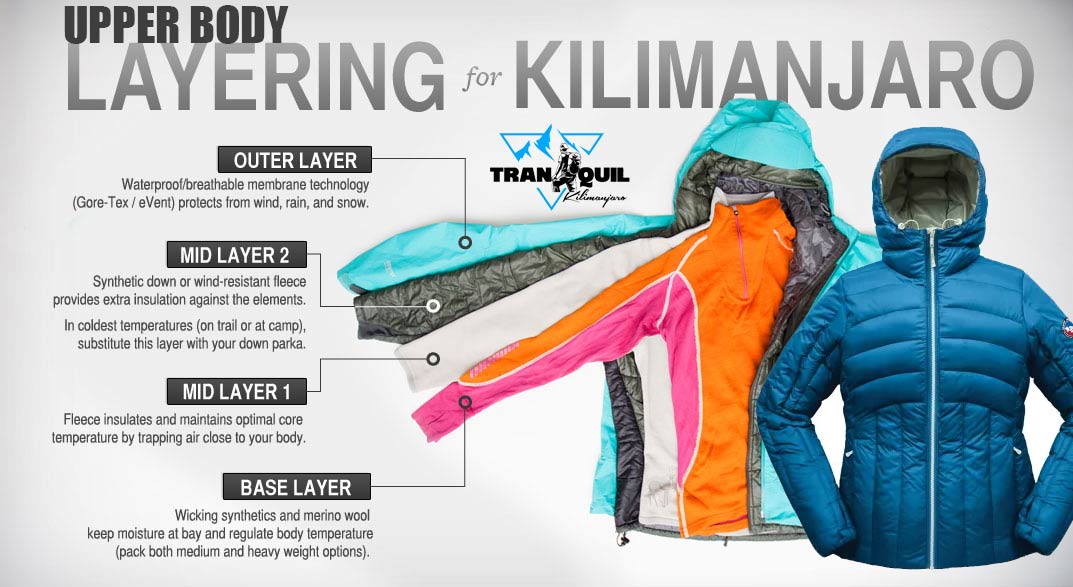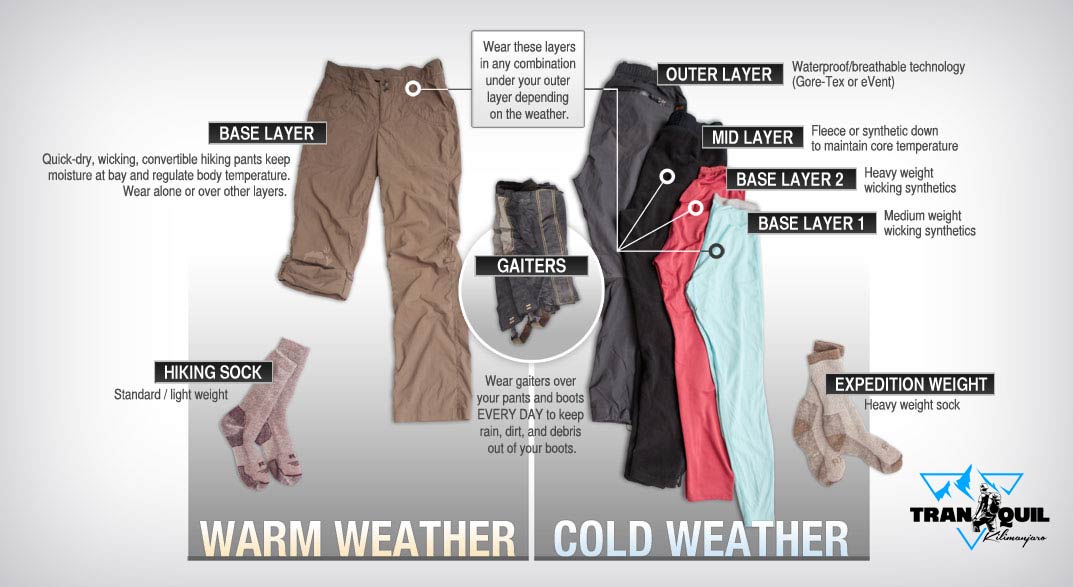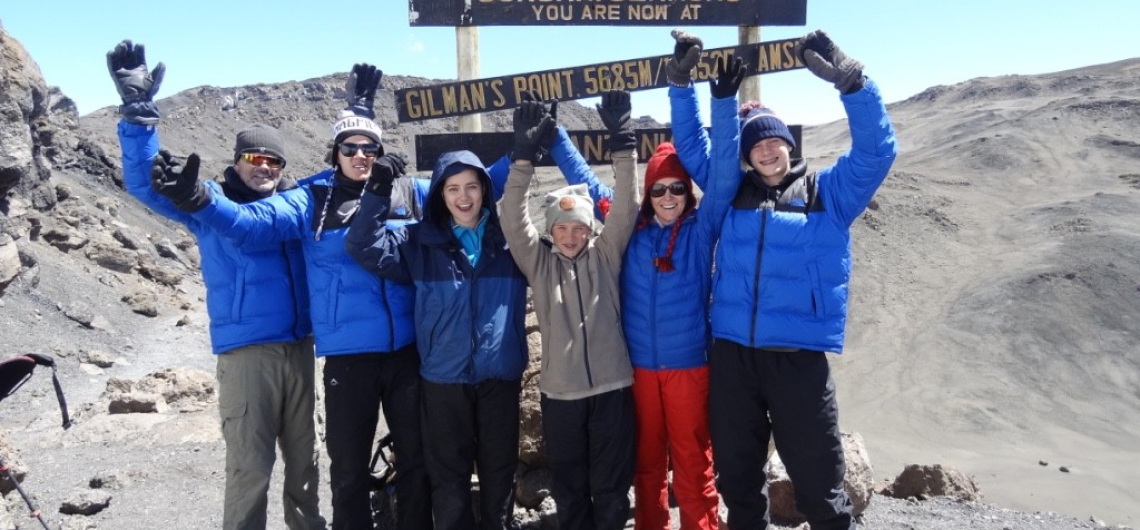The layering system for hiking gear is a strategic way that incorporates wearing multiple clothing layers to regulate your body temperature, manage moisture, and make you feel comfortable and keep you warm while facing harsh mountainous conditions like on Mount Kilimanjaro, Mount Kenya, Rwenzori, Mount Meru or even Ol Doinyo Lengai.
When hiking, you wear clothes to comfort you and protect you from the harsh and sometimes unpredictable weather, the higher you climb. That is where the 3-layer system of dressing in layers comes in as it is the best way to prepare for any outdoor adventure.
The system typically consists of three main layers: the base layer, the insulating layer, and the outer layer. Each layer serves a specific purpose:
The Ultimate Kilimanjaro Climbing Gear Recommendations Checklist
What is the 3-layer System for hiking?
- Base Layer: This layer is responsible for wicking sweat away from your body to keep you dry. Materials like synthetic fabrics or merino wool work best because they dry quickly and help regulate your temperature.
- Middle Layer (Insulation): This layer traps body heat to keep you warm. Fleece or down jackets are common choices, providing insulation even in cold conditions.
- Outer Layer (Shell): The outer layer protects you from wind, rain, and snow. Waterproof and windproof fabrics, like Gore-Tex, are essential to keep moisture out while still allowing some breathability.
Why is it Important to Dress in Layers?
Each layer serves a specific purpose, ensuring you’re prepared for changing weather conditions or activity levels. Weatherproof layers block out wind and rain, but they aren’t always breathable enough on their own to keep you comfortable during intense activity. Meanwhile, insulation layers keep you warm, but moisture from sweat can make you cold if it doesn’t escape.
By using different layers, you create a flexible clothing system that adapts to your needs. You can adjust for warmth by adding or removing layers based on the weather or your activity. For example, when it’s warmer or you’re moving quickly, you can take off insulation layers and rely on your base layer or just the shell. The key is to bring enough layers so you can adjust as needed because you can always take a layer off, but you can’t add what you didn’t pack.
In short, layering helps you stay warm, dry, and comfortable, no matter what conditions you encounter on the mountain.
Upper body layering
 Staying warm and dry on Mount Kilimanjaro is key to having a successful trek, and it’s easy to do if you know how to layer your clothes properly. Each layer has a specific job, so it’s important not to skip any when you pack. Here’s a simple guide to layering for your upper body:
Staying warm and dry on Mount Kilimanjaro is key to having a successful trek, and it’s easy to do if you know how to layer your clothes properly. Each layer has a specific job, so it’s important not to skip any when you pack. Here’s a simple guide to layering for your upper body:
1. Base Layer (Pack both medium and heavy options)
The base layer sits next to your skin and helps manage sweat while keeping your body temperature stable. Materials like synthetic fabrics or merino wool are perfect for this.
- Recommended: SmartWool Midweight Long Underwear, Patagonia Capilene 4
2. Mid Layer 1 (Fleece)
The first mid-layer traps heat by holding warm air close to your body. As temperatures drop, this layer helps you stay cosy.
- Recommended: Mammut Aconcagua Hoodie, Patagonia Better Sweater
3. Mid Layer 2 (Insulation)
Add a second mid-layer, like synthetic down or a wind-resistant fleece, to stay warm as it gets colder. For the coldest conditions, swap this layer for a puffy down jacket to get the best insulation.
- Recommended: First Ascent Igniter Jacket, Arc’teryx Gamma MX Hoodie
4. Outer Layer (Waterproofing)
Your outer layer protects you from wind and rain. Look for waterproof but breathable fabrics like Gore-Tex to stay dry without overheating.
- Recommended: Arc’teryx Alpha SL Jacket, Outdoor Research Foray Rain Jacket
Lower body Layering
 By layering properly, you can handle any weather Kilimanjaro throws at you. Don’t forget to layer your pants and socks for full protection against the changing temperatures! Here’s a simple guide to layering your lower body for different weather conditions while hiking:
By layering properly, you can handle any weather Kilimanjaro throws at you. Don’t forget to layer your pants and socks for full protection against the changing temperatures! Here’s a simple guide to layering your lower body for different weather conditions while hiking:
Warm Weather Base Layer
In warm weather, quick-dry, convertible hiking pants are your go-to. You can wear them on their own, and in colder weather, you can layer them over your base and mid-layers.
- Recommended: Marmot Lobo Convertible Pant, Mountain Hardwear Mesa V2 Pant
Base Layer 1 (Cold Weather)
For cold weather, start with a medium-weight base layer made of synthetic fabric or merino wool. This helps manage moisture and keeps you warm.
- Recommended: SmartWool Midweight Long Underwear
Base Layer 2 (Colder Weather)
As temperatures drop further, add a heavier base layer, such as fleece tights or pants made of synthetic material or merino wool, for extra warmth.
- Recommended: REI Grand Teton Fleece Tights, Mammut Denali Pant
Mid Layer (Cold Weather)
On really cold days, add a wind-resistant fleece or synthetic down layer for additional insulation. Climbing pants in this layer will help keep you warm while blocking the wind.
- Recommended: First Ascent Igniter Pant, Marmot Orion Pant
Outer Layer (Cold and Wet Weather)
When you’re hiking in snow or rain, you’ll need a waterproof outer layer to stay dry. Look for pants made with materials like Gore-Tex to protect against moisture while remaining breathable.
- Recommended: Arc’teryx Beta SL Rain Pant, Arc’teryx Alpha SL Full Zip Rain Pant
By layering properly, you’ll be ready for any weather, from warm sunny days to cold, wet conditions on the trail!
The Layering Concept for hiking gear
When hiking Kilimanjaro, dressing properly is key to staying warm, dry, and comfortable in changing weather. The best way to achieve this is by using the layering system, also known as the 3-layer system. This approach allows you to manage body temperature, moisture, and protection from the elements effectively. Here’s a breakdown of the system:
1. Base Layer: Moisture Management
The base layer, or “next-to-skin” layer, is designed to wick sweat away from your body, keeping you dry and comfortable. It should be snug without being tight. Materials like synthetic fabrics (polyester, nylon) or merino wool are great choices because they dry quickly and regulate body temperature. A good base layer prevents that cold, clammy feeling when you sweat.
2. Middle Layer: Insulation
The middle layer’s job is to keep you warm by trapping heat close to your body. This layer can be made of fleece, down, or synthetic insulation, depending on the temperature. The thickness of the middle layer can vary, and in extremely cold conditions, you can even wear multiple insulating layers for added warmth.
3. Outer Layer: Weather Protection
The outer layer, also known as the shell, shields you from wind, snow, and rain. This layer should be waterproof, windproof, and breathable to keep you dry while allowing sweat to escape. Look for materials like Gore-Tex or similar fabrics that offer these protective features. Outer layers can be either hard shells (better protection against rain and wind) or soft shells (better breathability and flexibility).
Benefits of Using Multiple Layers
Using multiple layers provides several advantages for warmth, moisture control, and flexibility:
- Temperature Regulation: Layering allows you to adjust your clothing easily as weather or activity levels change. For example, you can add more insulation when it’s cold or remove layers if you’re getting too warm.
- Moisture Management: Each layer helps control moisture. The base layer wicks sweat away, the middle layer retains warmth, and the outer layer protects from external moisture like snow or rain while allowing sweat to evaporate.
- Better Warmth: Multiple thin layers trap heat more effectively than one bulky layer, creating air pockets that act as natural insulation.
- Increased Mobility: Using several lighter layers instead of a heavy coat gives you more freedom of movement, which is important for hiking.
- Versatility: Layering makes your outfit adaptable. If the weather changes or your activity level increases, you can remove or add layers to stay comfortable.
The Role of the Base Layer in hiking
The base layer is crucial for moisture-wicking and thermal regulation:
- Moisture-Wicking: As you ski, your body generates heat, causing sweat. A good base layer pulls this moisture away from your skin, keeping you dry and preventing cooling when the sweat evaporates. This helps avoid discomfort and reduces the risk of hypothermia.
- Thermal Regulation: The base layer also traps body heat, creating a thin insulating barrier between your skin and the cold air. This helps maintain your body temperature, even in chilly conditions.
Types of Base Layer Materials
- Synthetic Fabrics (Polyester, Nylon): These materials are excellent for moisture-wicking and dry quickly, making them ideal for high-intensity activities like hiking and skiing.
- Merino Wool: A natural fibre that is great for managing moisture, providing extra insulation, and offering odour resistance, making it a great option for multi-day trips.
When selecting a base layer, ensure it fits snugly but comfortably to optimize moisture management and thermal regulation. A well-chosen base layer is the foundation for staying warm, dry, and comfortable on the slopes.
Mid-Layer: Added Warmth and Comfort
Wearing a mid-layer while hiking or during other outdoor activities is essential for maintaining warmth and comfort, especially in cold weather. Here’s why you should include a mid-layer in your clothing system:
- Enhanced Warmth: The mid-layer provides an extra layer of insulation, trapping warm air between your base and outer layers. This helps keep you warm in colder temperatures or at higher altitudes, making it easier to stay comfortable and enjoy your activity longer.
- Customizable Comfort: Mid-layers come in different weights and thicknesses, so you can choose the right one for the weather and your activity level. This flexibility allows you to add or remove layers depending on how cold or warm you feel, making it a vital part of your outfit.
- Improved Breathability: Many mid-layers are designed with breathable materials that let excess heat and moisture escape, preventing you from overheating during intense activities. This keeps your body temperature balanced and improves overall comfort.
Types of Mid-Layers
You have several options when it comes to choosing a mid-layer. Each type offers unique benefits suited to different conditions:
- Fleece Jackets: Lightweight and breathable, fleece provides warmth without adding bulk. It’s a popular mid-layer choice because it traps heat while allowing moisture to escape, making it perfect for cold, dry conditions.
- Softshell Layers: Softshells combine warmth, breathability, and some level of water resistance. They’re great for active outdoor adventures like trekking, where you might encounter light rain or wind but still need breathability.
- Hybrid Materials: These mid-layers combine fabrics like fleece and softshell materials to maximize warmth and mobility. They often feature stretchy areas for better movement and breathability where needed most.
- Synthetic Insulated Jackets: These jackets use synthetic insulation, which retains warmth even when wet. They are ideal for damp conditions, offering both warmth and quick-drying capabilities.
- Down Jackets: Down provides excellent warmth for its weight and packs down easily, but it loses its insulation properties when wet. It’s best for dry, cold conditions, and should be paired with a waterproof outer layer in wet environments.
Outer Layer: Protection From the Elements
The outer layer, or “shell,” is the final layer in your hiking clothing system. Its primary function is to protect you from wind, snow, and moisture while still allowing perspiration to escape.
- Wind Protection: Wind can quickly chill your body, making it hard to stay warm. A windproof outer layer blocks cold air from reaching your body, preventing wind chill and helping you retain body heat.
- Snow and Rain Protection: When hiking, you’re often exposed to rain, and sometimes ice. A good outer layer will be waterproof or water-resistant, ensuring that snow or rain doesn’t seep into your clothing. Features like taped seams and waterproof zippers also help keep moisture out.
- Breathability: Your outer layer must be breathable so that sweat can escape. Many outer layers include ventilation options like underarm zippers, allowing you to release heat without removing your jacket.
The Importance of Waterproof and Breathable Materials
Using waterproof and breathable materials in your outer layer ensures you stay dry and comfortable throughout your time outdoors. Here’s why these features are essential:
- Moisture Protection: Waterproof fabrics prevent external moisture, like snow or rain, from penetrating your clothing, keeping you dry and comfortable.
- Temperature Regulation: These fabrics also allow moisture from sweat to escape, preventing you from getting too hot or too cold. This balance keeps your body temperature stable, no matter the weather.
- Ease of Movement: Modern waterproof materials are flexible and lightweight, so they won’t restrict your movement. This is especially important for activities like hiking, where you need agility and movement.
- Versatility: Waterproof and breathable materials are great for a variety of outdoor activities such as hiking or snowboarding, ensuring you’re prepared for any weather.
- Durability: Many waterproof materials are built to withstand the wear and tear of outdoor activities, meaning they’ll last longer and perform well in tough conditions.
By understanding the role of each layer and choosing materials that suit the activity and environment, you can stay comfortable, warm, and dry while hiking or enjoying other outdoor adventures.
![]()


Comments